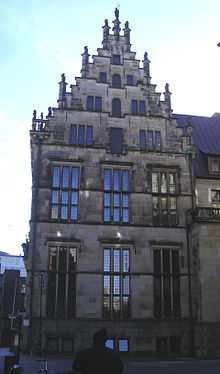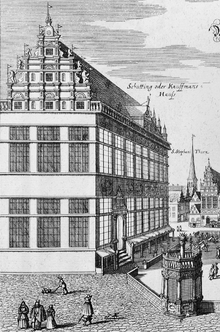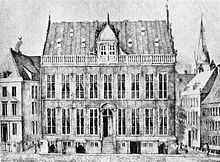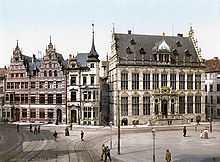Schütting (Bremen)

The Schütting, situated on the Marktplatz (market square) in Bremen, Germany, initially served the city's merchants and tradesmen as a guild house. In 1849, it became Bremen's chamber of commerce. Since 1973, it has been a listed building.[1]

Locality
The first guildhall of the merchants had been situated in Langenstraße on the corner with Hakenstraße, which originally had been the corner of the market place near Bremen's first port at river Balge, a branch of the Weser. After the limit of the market had shifted eastward and in 1405 the city of Bremen had built a new townhall (at its present site), the aldermen in 1425 purchased a particular house on the opposite side of the market on the ground of today's Schütting, in order to be as present at the market place as the urban senate, again. After their move to the new address, they sold their previous guildhall in 1444. In the same year, the name Schütting was used for the first time.
Name
Merchants' guildhalls named "Schütting" exist or have existed also in Bergen (Norway), there called Scotting, and in Lübeck, Lüneburg, Oldenburg (since 1604), Osnabrück and Rostock. They all did not only serve adminitrative tasks and sicial events, but also shelter for foreign merchants. Therefore, the name can be related to the German word schützen meaning "to protect".
Building history



In 1538, the merchants of Bremen charged the Flemish mason and architect Johann den Buschener from Antwerp, who constructed a new building in 1538/39, but, due to financial limits, the fine design of the façades lasted much longer. Buschener only completed the stepped western gable, which is on the borderline of Late Gothic and of Renaissance style, and the main entrance, which was not yet central. The eastern gable, pure Renaissance, was crafted in 1565 by a local mason named Karsten Husmann. In 1594, the cornice overlooking the market square was enhanced by a magnificent maritime gable. Lüder von Bentheim, the architect of the Renaissance refresher of the townhall, was engaged in it, too.
In the 18th and 19th centuries, the facade was altered several times: In 1756, Theophilus Freese removed the decentral entrance by a decent central one and reduced the number of horizontal cornices, thus changing the style to a modest kind of Baroque. In mid 19th century the line of low shops in front of the basement was removed, and for the first time a twin staircase to the entrance door was built.
In Wilhelminism, people disliked the noble modesty of the building. In 1895 to 1899, the number of corniches was raised and above the windows relief ornaments were placed. The present bombastic portal was constructed. Above the door, a Low German inscription was added, lately invented by Bremen's mayor Otto Gildemeister
- buten un binnen
- wagen un winnen
(literally "Outside and in, risk it and win") was added as a motto, meaning that merchants from Bremen are called upon to risk their assets at home and abroad in order to gain fortune. The motto was created by mayor Otto Gildemeister.[2]
The building with its magnificent interior and its valuable furnishings burnt to the ground on 6 October 1944. Reconstruction was completed in 1956. Except for the dormers on the facade overlooking the market square, the exterior was rebuilt, as it had been since 1899, while the interior was reconfigured. In 1951, the chamber of commerce moved into the ground floor. The second stage of the reconstruction took place over the next five years, including the second floor interior. In 2009, the faҫade and copper-covered roof were repaired and the dormers were rebuilt. The firm which performed the work received an award in 2010 from the Landesamt für Denkmalspflege (State of Bremen office for the preservation of monuments and historic buildings).[3]
Usage

The year 1451 saw the establishment of the organisation representing the merchants of Bremen. The relations between the merchants were regularised by a treaty named “Ordinantie”, dated 10 January 1451. Until 1849, the organisation bore the name of “Collegium Seniorum”. Thereafter, it changed its name to Bremer Handelskammer (Bremen chamber of commerce).
The first coffee house in the German-speaking countries came into being in Bremen in 1673. Its exact location is not known, but from 1679 onwards, it was located in the Schütting.[4]
In the basement of the Schütting, a traditional gentlemen's club, the “Club zu Bremen”, has its club rooms. Since the year 2000, it has been open to female members, too.
Literature
- Schwarzwälder, Herbert (2003). Das Große Bremen-Lexikon (in German). Edition Temmen. ISBN 3-86108-693-X.
- Konrad Elmshäuser, Hans-Christoph Hoffmann, Hans-Joachim Manske: Das Rathaus und der Roland auf dem Marktplatz in Bremen (Print of the UNESCO World Heritage candidacy); Edition Temmen, Bremen, 2002, ISBN 3-86108-682-4.
- Rudolf Stein, Romanische, gotische und Renaissance-Baukunst in Bremen, Bremen 1962 (in the public library of Bremen state archive)
- Lydia Niehoff: 550 Jahre – Tradition der Unabhängigkeit, Chronik der Handelskammer Bremen. Schünemann Verlag, Bremen 2001, ISBN 3-7961-1827-5.
- Peter Hahn: 450 Jahre Haus Schütting, Sitz der Handelskammer Bremen. Die Baugeschichte. Hrsg.: Handelskammer Bremen. Schünemann Verlag, Bremen 1988, ISBN 3-7961-1797-X.
- H. A. Schumacher: Zur Geschichte des Schüttings. In: Bremisches Jahrbuch. Band 5, Bremen 1870, S. 192–214.
References
- ↑ Database of Landesamt für Denkmalpflege Bremen #0072 (German)
- ↑ Kloos, Werner (1980). Bremer Lexikon - Lemma Buten un Binnen, Wagen un Winnen (in German). Hauschild Verlag Bremen. ISBN 9783920699318.
- ↑ "Verleihung des Bremer Denkmalpflegepreises 2010". Landesamt für Denkmalpflege. Retrieved December 5, 2013.
- ↑ Niehoff, Lydia (2001). 550 Jahre Tradition der Unabhängigkeit. Schünemann Verlag Bremen. ISBN 9783796118272. S. 92. (German)
External links
| Wikimedia Commons has media related to Schütting. |
- Official website (German) (English)
Coordinates: 53°4′32″N 8°48′24″E / 53.07556°N 8.80667°E